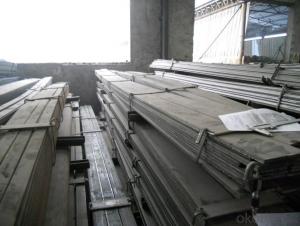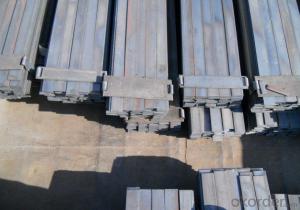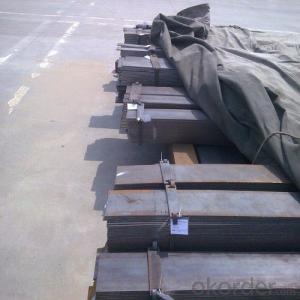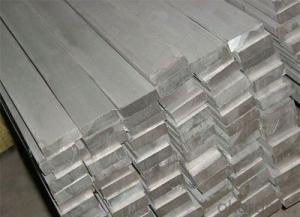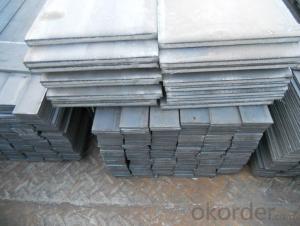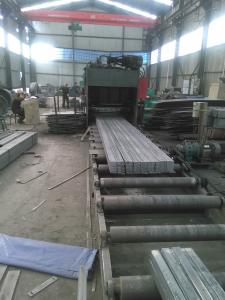Flat Steel Bar
- Loading Port:
- China Main Port
- Payment Terms:
- TT OR LC
- Min Order Qty:
- -
- Supply Capability:
- -
OKorder Service Pledge
OKorder Financial Service
You Might Also Like
Product Description:
Spring Steel can be divided into two types. One is carbon spring steel, and other one is alloy spring steel.
Alloy spring steel is based on carbon spring steel, by adding one or more alloying elements to improve the mechanical properties, hardenability and other properties to meet the requirement for manufacturing all kinds of spring steel.
Specification of Spring Steel:
-Material: 70Si2CrA
-Production: Hot rolled or cold rolled
-Standard: GB/T·5218-1999
-Type: Spring Steel
-Alloy or no: Alloy
Chemical Composition:
C | Mn | Si | Cr |
0.65~0.75 | 0.40~0.60 | 1.40~1.70 | 0.20~0.40 |
S | P | Ni | |
≤0.030 | ≤0.030 | ≤0.030 | |
Mechanical Properties:
-Annealing Condition:
1, Tensile Strength: σb/MPa:≤835
2, Elongation: δ/%:≥8
-Quencher condition:
1, Tensile strength: σb/MPa:785~1175
2, Elongation: -
Usage/Applications of Spring Steel:
For manufacturing all kinds of flat spring or round spring with small sections, clockwork spring,
Packaging & Delivery of Spring Steel:
-Packing Detail: The products can be packed in bundles by steel wires.
-Marks:
1, Tag marks: the tag marks will be tied up to each bundle of the products. The information is usually including supplier’s logo and name, product name, made in China, products’ specifications, the painted color and other information requested by customers.
2, Color marks: we will paint both ends of the bundles of these products to make sure that they are more evident. It’s will be more convenient for the customers to distinguish them at the destination port.
-Delivery Detail:
1, Delivery time: 30~45 working days after receive buyer’s T.T. or L/C.
2, Delivery status should be written in the contract. (Heat treatment or no)
Payment:
-Invoicing on theoretical weight or actual weight as customer’s request.
-FOB, CFR or CIF.
-Regular terms of payment:
1, 30% payment in advance, the remaining balance (70% payment) against the copy of B/L. 100% payment before shipment.
2, 30% payment in advance, the remaining balance (70% L/C) against the copy of B/L. 100% payment before shipment.
3, Negotiable.
- Q:Are steel flat bars used in structural engineering?
- Steel flat bars are a common choice in structural engineering for a variety of applications. These versatile flat bars can be used to construct beams, columns, braces, and other structural elements. They provide essential support and stability in buildings, bridges, and infrastructure projects. Steel flat bars are renowned for their strength, durability, and resistance to deformation, making them an excellent option in structural engineering. They can be effortlessly welded, bolted, or riveted to other steel components, enabling efficient and cost-effective construction. In summary, steel flat bars are vital in structural engineering and have extensive use in the industry.
- Q:Can steel flat bars be used for manufacturing agricultural machinery?
- Yes, steel flat bars can be used for manufacturing agricultural machinery. Steel is a versatile and strong material that is commonly used in various industries, including agriculture. Steel flat bars offer several advantages such as high strength, durability, and resistance to corrosion, making them suitable for agricultural machinery. They can be used in the fabrication of equipment like plows, harrows, cultivators, and seeders, providing the necessary structural support and stability. Additionally, steel flat bars can be easily welded, bent, and formed into different shapes, allowing for customization and efficient manufacturing of agricultural machinery. Overall, steel flat bars are a reliable and cost-effective choice for manufacturing agricultural machinery due to their strength, durability, and versatility.
- Q:How do steel flat bars perform in terms of chemical resistance?
- The chemical resistance of steel flat bars is generally good, but it can vary depending on the grade and composition of the steel. Stainless steel flat bars, for instance, have exceptional resistance to a wide range of chemicals, including acids, alkalis, and organic solvents. This is because stainless steel contains a high amount of chromium, which creates a protective oxide layer on the surface known as passive film. This film prevents corrosion and chemical attack. On the contrary, carbon steel flat bars are more prone to corrosion but still display satisfactory chemical resistance in many environments. They can withstand most organic chemicals but may be affected by strong acids, alkalis, and specific corrosive substances. To enhance the chemical resistance of carbon steel in such cases, protective coatings or surface treatments can be applied. In general, steel flat bars are widely used across various industries due to their favorable chemical resistance. However, it is crucial to consider the specific grade and composition of the steel, as well as the intended application and the specific chemicals it will be exposed to, in order to determine the necessary level of chemical resistance.
- Q:Are steel flat bars suitable for making brackets or supports?
- Certainly, steel flat bars prove to be a fitting choice when it comes to crafting brackets or supports. Given their robustness and longevity, they stand as an optimal solution for rendering structural reinforcement. The ease of cutting, shaping, and welding empowers the creation of tailor-made brackets or supports, apt for diverse applications. Moreover, steel flat bars exhibit remarkable resistance against bending and twisting forces, thereby guaranteeing steadfastness and dependability in any construction or engineering endeavor.
- Q:Can roof strip be replaced with steel pipe instead of flat steel and round steel? Are there any examples of practical use?
- Steel pipes can be used instead of flat steel or round steel, and some of the structures on the buildings are connected and grounded by using steel pipe handrails on the walls of their daughters.
- Q:Can steel flat bars be used for load-bearing applications?
- Absolutely, load-bearing applications can certainly make use of steel flat bars. Steel is renowned for its robustness and endurance, rendering it a highly favored option for various structural purposes. In particular, flat bars possess remarkable load-bearing capabilities owing to their expansive surface area, which facilitates even load distribution. They find widespread employment in construction ventures, including the reinforcement of beams, frames, and bracing systems, as well as in the fabrication of machinery and industrial equipment. Furthermore, steel flat bars can be effortlessly joined together through welding, bolting, or screwing, enabling the creation of customized load-bearing structures. Consequently, they emerge as an adaptable and trustworthy choice for such applications.
- Q:Are steel flat bars resistant to impact?
- Yes, steel flat bars are generally resistant to impact due to their high strength and toughness properties. The ability of steel to absorb and distribute impact forces makes it a reliable material for applications where impact resistance is required. However, the specific resistance may vary depending on the grade and thickness of the steel used.
- Q:Can steel flat bars be used in the manufacturing of material handling equipment?
- Yes, steel flat bars can be commonly used in the manufacturing of material handling equipment. They provide strength, durability, and stability, making them suitable for various applications such as conveyor systems, lifting equipment, and storage racks. Additionally, steel flat bars can be easily welded, bent, and formed into desired shapes, allowing flexibility in design and customization for specific equipment requirements.
- Q:What is the typical length of a steel flat bar?
- The typical length of a steel flat bar can vary, but it is commonly available in lengths ranging from 6 to 20 feet.
- Q:What is the difference between a steel flat bar and a steel square bar?
- The main difference between a steel flat bar and a steel square bar lies in their shape and dimensions. A steel flat bar, as the name suggests, has a flat rectangular shape with a uniform thickness throughout its length. This makes it suitable for various applications such as supports, braces, and framework. On the other hand, a steel square bar has a square cross-section with equal sides. This shape provides additional strength and stability, making it ideal for applications that require structural support or load-bearing capabilities. Square bars are commonly used in construction, manufacturing, and engineering projects where strength and rigidity are crucial. While both steel flat bars and steel square bars are made of the same material, their shapes and dimensions affect their functionality and areas of application. The choice between the two largely depends on the specific requirements of the project and the intended use of the steel bar.
1. Manufacturer Overview |
|
|---|---|
| Location | |
| Year Established | |
| Annual Output Value | |
| Main Markets | |
| Company Certifications | |
2. Manufacturer Certificates |
|
|---|---|
| a) Certification Name | |
| Range | |
| Reference | |
| Validity Period | |
3. Manufacturer Capability |
|
|---|---|
| a)Trade Capacity | |
| Nearest Port | |
| Export Percentage | |
| No.of Employees in Trade Department | |
| Language Spoken: | |
| b)Factory Information | |
| Factory Size: | |
| No. of Production Lines | |
| Contract Manufacturing | |
| Product Price Range | |
Send your message to us
Flat Steel Bar
- Loading Port:
- China Main Port
- Payment Terms:
- TT OR LC
- Min Order Qty:
- -
- Supply Capability:
- -
OKorder Service Pledge
OKorder Financial Service
Similar products
New products
Hot products
Hot Searches
Related keywords







